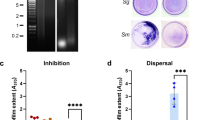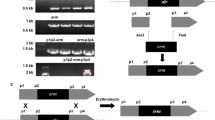Abstract
The periodontal pathogen, Aggregatibacter actinomycetemcomitans is extremely sensitive to even a mildly acidic pH resulting from metabolic acids secreted during growth, losing viability rapidly as the pH goes below 6.0. Cells grown at high glucose concentration grow fast but rapidly lose viability. However, if the cells are grown at low glucose concentration, the pH of the growth medium first decreases slowly for about 24 h and then starts to increase. This increase of pH is indicative of cell death since the spontaneous rise of pH due to the presence of bicarbonate can no longer be opposed by secreted metabolic acids. By monitoring these pH changes on a petri dish, a method was developed to screen for sugar transport-deficient mutants from a library of transposon insertion mutants. Isolation of a mannose phosphotransferase mutant strain is described. The mutant cells were found to be more viable and for a longer period of time than wild-type cells both in high and low glucose concentrations due to slower metabolism and less acid secreted. This observation highlights the concern that spontaneous mutations in the sugar transport genes may be selected for in patients due to increased viability of the mutant cells especially in a biofilm.




Similar content being viewed by others
References
Henderson B, Nair SP, Ward JM, Wilson M (2003) Molecular pathogenicity of the oral opportunistic pathogen Actinobacillus actinomycetemcomitans. Annu Rev Microbiol 57:29–55
Yew HS, Chambers ST, Roberts SA, Holland DJ, Julian KA, Raymond NJ, Beardsley J, Read KM, Murdoch DR (2014) Association between HACEK bacteraemia and endocarditis. J Med Microbiol 63:892–895
Fine DH, Furgang D, Schreiner HC, Goncharoff P, Charlesworth J, Ghazwan G, Fitzgerald-Bocarsly P, Figurski DH (1999) Phenotypic variation in Actinobacillus actinomycetemcomitans during laboratory growth: implications for virulence. Microbiology 145:1335–1347
Bhattacharjee MK, Sugawara K, Ayandeji OT (2009) Microwave sterilization of growth medium alleviates inhibition of Aggregatibacter actinomycetemcomitans by Maillard reaction products. J Microbiol Methods 78:227–230
Bhattacharjee MK, Delsol JK (2014) Does microwave sterilization of growth media involve any non-thermal effect? J Microbiol Methods 96:70–72
Bhattacharjee MK, Childs CB, Ali E (2011) Sensitivity of the periodontal pathogen Aggregatibacter actinomycetemcomitans at mildly acidic pH. J Periodontol 82:917–925
Lilienthal B (1955) Buffering systems in the mouth. Oral Surg Oral Med Oral Pathol 8:828–841
Thomson VJ, Bhattacharjee MK, Fine DH, Derbyshire KM, Figurski DH (1999) Direct selection of IS903 transposon insertions by use of a broad-host-range vector: isolation of catalase-deficient mutants of Actinobacillus actinomycetemcomitans. J Bacteriol 181:7298–7307
Crosby JA, Kachlany SC (2007) TdeA, a TolC-like protein required for toxin and drug export in Aggregatibacter (Actinobacillus) actinomycetemcomitans. Gene 388:83–92
Kachlany SC, Planet PJ, Bhattacharjee MK, Kollia E, DeSalle R, Fine DH, Figurski DH (2000) Nonspecific adherence by Actinobacillus actinomycetemcomitans requires genes widespread in bacteria and archea. J Bacteriol 182:6169–6176
Kaplan JB, Velliyagounder K, Ragunath C, Rohde H, Mack D, Knobloch JK, Ramasubbu N (2004) Genes involved in the synthesis and degradation of matrix polysaccharide in Actinobacillus actinomycetemcomitans and Actinobacillus pleuropneumoniae biofilms. J Bacteriol 186:8213–8220
Keeney D, Ruzin A, McAleese F, Murphy E, Bradford PA (2008) MarA-mediated overexpression of AcrAB efflux pump results in decreased susceptibility to tigecycline in Escherichia coli. J Antimicrob Chemother 61:46–53
Sia E, Kuehner DM, Figurski DH (1996) The mechanism of retrotransfer in conjugation: prior transfer of the congugative plasmid is required. J Bacteriol 178:1457–1464
Triglia T, Peterson M, Kemp D (1988) A procedure for in vitro amplification of DNA segments that lie outside the boundaries of known sequences. Nucl Acids Res 16:8186
Bhattacharjee MK, Fine DH, Figurski DH (2007) tfoX (sxy)-dependent transformation of Aggregatibacter (actinobacillus) actinomycetemcomitans. Gene 399:53–64
Ellwood DC, Phipps PJ, Hamilton IR (1979) Effect of growth rate and glucose concentration on the activity of the phosphenolpyruvate phosphotransferase system in Streptococcus mutans Ingbritt grown in continuous culture. Infect Immun 23:224–231
Steinsiek S, Bettenbrock K (2012) Glucose transport in Escherichia coli mutant strains with defects in sugar transport systems. J Bacteriol 194:5897–5908
Pelletier G, Frenette M, Vadeboncoeur (1994) Transport of mannose by an inducible phosphoenolpyruvate:fructose phosphotransferase system in Streptococcus salivarius. Microbiology 140:2433–2438
Takahashi N, Yamada T (1999) Acid-induced acid tolerance and acidogenicity of non-mutans streptococci. Oral Microbiol Immunol 14:43–48
Cotter PD, Hill C (2003) Surviving the acid test: responses of gram-negative bacteria to low pH. Microbiol Mol Biol Rev 67:429–453
Van-Hout J, Lodman J, Kent R (1996) The final pH of bacteria comprising the predominant flora on sound and carious human root and enamel surfaces. J Dent Res 75:1008–1014
Brown SA, Whiteley M (2007) A novel exclusion mechanism for carbon resource partitioning in Aggregatibacter actinomycetemcomitans. J Bacteriol 189:6407–6414
Yebra MJ, Moneder V, Zuniga M, Deutscher J, Perez-Martinez G (2006) Molecular analysis of the glucose-specific phosphoenolpyruvate: sar phosphotransferase system from Lactbacillus casei and its links with the control of sugar metabolism. Microbiology 152:95–104
Jahreis K, Pimentel-Schmitt EF, Brückner R, Titgemeyer F (2008) Ins and outs of glucose transport systems in eubacteria. FEMS Microbiol Rev 32:891–907
Robillard GT, Broos J (1999) Structure/function studies on the bacterial carbohydrate transporters, enzymes II, of the phosphoenolpyruvate-dependent phosphotransferase system. Biochim Biophys Acta 1422:73–104
Veyrat A, Monedero V, Perez-Martinez G (1994) Glucose transport by the phosphoenolpyruvate: mannose phosphotransferase system in Lactobacillus casei ATCC 393 and its role in carbon catabolite repression. Microbiology 140:1141–1149
Liberman ES, Bleiweis AS (1984) Transport of glucose and mannose by a common phosphoenolpyruvate-dependent phosphotransferase system in Streptococcus mutans GS5. Infect Immun 43:1106–1109
Galgut PN (2001) The relevance of pH to gingivitis and periodontitis. J Int Acad Periodontol 3:61–67
Xiao J, Hara AT, Kim D, Zero DT, Koo H, Huang G (2017) Biofilm three-dimensional architecture influences in situ pH distribution pattern on the human enamel surface. Int J Oral Sci 9:74–79
Author information
Authors and Affiliations
Corresponding author
Ethics declarations
Conflict of interest
The authors declare that they have no conflict of interest.
Rights and permissions
About this article
Cite this article
Bhattacharjee, M.K., Anees, M. & Patel, A. Increased Viability of Sugar Transport-Deficient Mutant of the Periodontal Pathogen, Aggregatibacter actinomycetemcomitans. Curr Microbiol 75, 1460–1467 (2018). https://doi.org/10.1007/s00284-018-1545-6
Received:
Accepted:
Published:
Issue Date:
DOI: https://doi.org/10.1007/s00284-018-1545-6




